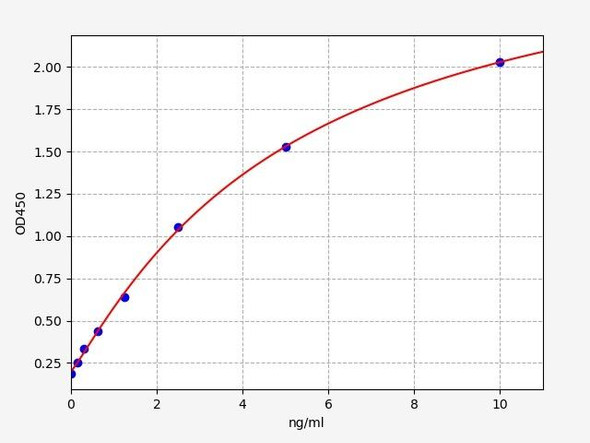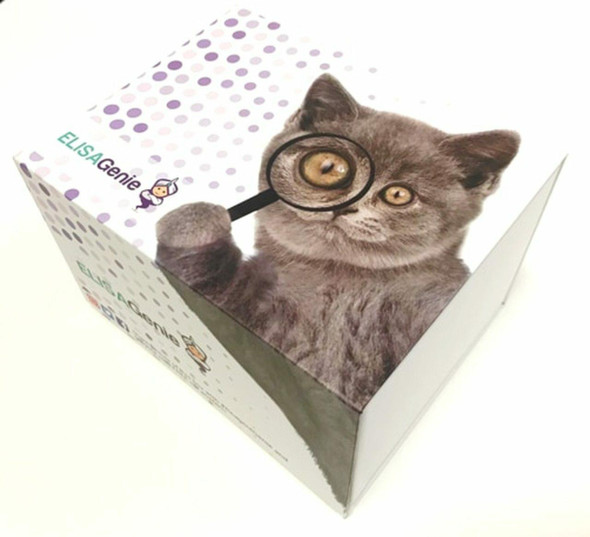Human Cell Biology ELISA Kits 5
Human CRY alphaB (Crystallin Alpha B) CLIA Kit (HUES00865)
- SKU:
- HUES00865
- Product Type:
- ELISA Kit
- ELISA Type:
- CLIA Kit
- Size:
- 96 Assays
- Sensitivity:
- 18.75pg/mL
- Range:
- 31.25-2000pg/mL
- ELISA Type:
- Sandwich
- Reactivity:
- Human
- Sample Type:
- Serum, plasma and other biological fluids
- Research Area:
- Cell Biology
Description
| Assay type: | Sandwich |
| Format: | 96T |
| Assay time: | 4.5h |
| Reactivity: | Human |
| Detection method: | Chemiluminescence |
| Detection range: | 31.25-2000 pg/mL |
| Sensitivity: | 18.75 pg/mL |
| Sample volume: | 100µL |
| Sample type: | Serum, plasma and other biological fluids |
| Repeatability: | CV < 15% |
| Specificity: | This kit recognizes Human CRY alphaB in samples. No significant cross-reactivity or interference between Human CRY alphaB and analogues was observed. |
This kit uses Sandwich-CLIA as the method. The micro CLIA plate provided in this kit has been pre-coated with an antibody specific to Human CRY alphaB. Standards or samples are added to the appropriate micro CLIA plate wells and combined with the specific antibody. Then a biotinylated detection antibody specific for Human CRY alphaB and Avidin-Horseradish Peroxidase (HRP) conjugate are added to each micro plate well successively and incubated. Free components are washed away. The substrate solution is added to each well. Only those wells that contain Human CRY alphaB, biotinylated detection antibody and Avidin-HRP conjugate will appear fluorescence. The Relative light unit (RLU) value is measured spectrophotometrically by the Chemiluminescence immunoassay analyzer. The RLU value is positively associated with the concentration of Human CRY alphaB. The concentration of Human CRY alphaB in the samples can be calculated by comparing the RLU of the samples to the standard curve.
| UniProt Protein Function: | CRYAB: a major structural protein of the eye lens. A member of the small heat shock protein (sHSP also known as the HSP20) family. Alpha-B is expressed in the lens as well as other tissues. Elevated expression of alpha-B crystallin occurs in many neurological diseases; a missense mutation cosegregated in a family with a desmin-related myopathy. |
| UniProt Protein Details: | Protein type:Heat shock protein; Chaperone Chromosomal Location of Human Ortholog: 11q22. 3-q23. 1 Cellular Component: actin filament bundle; cell surface; cytoplasm; cytosol; Golgi apparatus; microtubule cytoskeleton; mitochondrion; myelin sheath; nucleoplasm; nucleus; plasma membrane; Z disc Molecular Function:identical protein binding; metal ion binding; microtubule binding; protein binding; protein homodimerization activity; structural constituent of eye lens; unfolded protein binding Biological Process: aging; lens development in camera-type eye; microtubule polymerization or depolymerization; muscle contraction; muscle development; negative regulation of apoptosis; negative regulation of caspase activity; negative regulation of cell growth; negative regulation of intracellular transport; protein folding; protein homooligomerization; response to estradiol stimulus; response to hydrogen peroxide; response to hypoxia; stress-activated MAPK cascade; tubulin folding Disease: Cardiomyopathy, Dilated, 1ii; Cataract 16, Multiple Types; Myopathy, Myofibrillar, 2; Myopathy, Myofibrillar, Fatal Infantile Hypertonic, Alpha-b Crystallin-related |
| NCBI Summary: | Mammalian lens crystallins are divided into alpha, beta, and gamma families. Alpha crystallins are composed of two gene products: alpha-A and alpha-B, for acidic and basic, respectively. Alpha crystallins can be induced by heat shock and are members of the small heat shock protein (HSP20) family. They act as molecular chaperones although they do not renature proteins and release them in the fashion of a true chaperone; instead they hold them in large soluble aggregates. Post-translational modifications decrease the ability to chaperone. These heterogeneous aggregates consist of 30-40 subunits; the alpha-A and alpha-B subunits have a 3:1 ratio, respectively. Two additional functions of alpha crystallins are an autokinase activity and participation in the intracellular architecture. The encoded protein has been identified as a moonlighting protein based on its ability to perform mechanistically distinct functions. Alpha-A and alpha-B gene products are differentially expressed; alpha-A is preferentially restricted to the lens and alpha-B is expressed widely in many tissues and organs. Elevated expression of alpha-B crystallin occurs in many neurological diseases; a missense mutation cosegregated in a family with a desmin-related myopathy. Alternative splicing results in multiple transcript variants. [provided by RefSeq, Jan 2014] |
| UniProt Code: | P02511 |
| NCBI GenInfo Identifier: | 117385 |
| NCBI Gene ID: | 1410 |
| NCBI Accession: | P02511. 2 |
| UniProt Secondary Accession: | P02511,O43416, Q9UC37, Q9UC38, Q9UC39, Q9UC40, Q9UC41 B0YIX0, |
| UniProt Related Accession: | P02511 |
| Molecular Weight: | 20,159 Da |
| NCBI Full Name: | Alpha-crystallin B chain |
| NCBI Synonym Full Names: | crystallin alpha B |
| NCBI Official Symbol: | CRYAB |
| NCBI Official Synonym Symbols: | MFM2; CRYA2; CTPP2; HSPB5; CMD1II; CTRCT16; HEL-S-101 |
| NCBI Protein Information: | alpha-crystallin B chain |
| UniProt Protein Name: | Alpha-crystallin B chain |
| UniProt Synonym Protein Names: | Alpha(B)-crystallin; Heat shock protein beta-5; HspB5; Renal carcinoma antigen NY-REN-27; Rosenthal fiber component |
| Protein Family: | Alpha-crystallin |
| UniProt Gene Name: | CRYAB |
| UniProt Entry Name: | CRYAB_HUMAN |
As the RLU values of the standard curve may vary according to the conditions of the actual assay performance (e. g. operator, pipetting technique, washing technique or temperature effects), the operator should establish a standard curve for each test. Typical standard curve and data is provided below for reference only.
| Concentration (pg/mL) | RLU | Average | Corrected |
| 2000 | 51337 60105 | 55721 | 55693 |
| 1000 | 23668 24280 | 23974 | 23946 |
| 500 | 11561 10503 | 11032 | 11004 |
| 250 | 5208 5380 | 5294 | 5266 |
| 125 | 2665 2551 | 2608 | 2580 |
| 62.5 | 1315 1307 | 1311 | 1283 |
| 31.25 | 653 695 | 674 | 646 |
| 0 | 27 29 | 28 | -- |
Precision
Intra-assay Precision (Precision within an assay): 3 samples with low, mid range and high level Human CRY alphaB were tested 20 times on one plate, respectively.
Inter-assay Precision (Precision between assays): 3 samples with low, mid range and high level Human CRY alphaB were tested on 3 different plates, 20 replicates in each plate.
| Intra-assay Precision | Inter-assay Precision | |||||
| Sample | 1 | 2 | 3 | 1 | 2 | 3 |
| n | 20 | 20 | 20 | 20 | 20 | 20 |
| Mean (pg/mL) | 109.23 | 188.73 | 884.48 | 102.93 | 178.03 | 883.63 |
| Standard deviation | 9.95 | 18.00 | 59.61 | 12.69 | 14.62 | 90.13 |
| C V (%) | 9.11 | 9.54 | 6.74 | 12.33 | 8.21 | 10.20 |
Recovery
The recovery of Human CRY alphaB spiked at three different levels in samples throughout the range of the assay was evaluated in various matrices.
| Sample Type | Range (%) | Average Recovery (%) |
| Serum (n=5) | 94-111 | 102 |
| EDTA plasma (n=5) | 97-110 | 103 |
| Cell culture media (n=5) | 89-100 | 95 |
Linearity
Samples were spiked with high concentrations of Human CRY alphaB and diluted with Reference Standard & Sample Diluent to produce samples with values within the range of the assay.
| Serum (n=5) | EDTA plasma (n=5) | Cell culture media (n=5) | ||
| 1:2 | Range (%) | 100-115 | 89-102 | 90-102 |
| Average (%) | 106 | 96 | 96 | |
| 1:4 | Range (%) | 89-100 | 97-109 | 85-97 |
| Average (%) | 94 | 103 | 92 | |
| 1:8 | Range (%) | 96-111 | 101-117 | 102-116 |
| Average (%) | 102 | 107 | 110 | |
| 1:16 | Range (%) | 97-112 | 83-98 | 98-112 |
| Average (%) | 104 | 90 | 106 |
An unopened kit can be stored at 4°C for 1 month. If the kit is not used within 1 month, store the items separately according to the following conditions once the kit is received.
| Item | Specifications | Storage |
| Micro CLIA Plate(Dismountable) | 8 wells ×12 strips | -20°C, 6 months |
| Reference Standard | 2 vials | |
| Concentrated Biotinylated Detection Ab (100×) | 1 vial, 120 µL | |
| Concentrated HRP Conjugate (100×) | 1 vial, 120 µL | -20°C(shading light), 6 months |
| Reference Standard & Sample Diluent | 1 vial, 20 mL | 4°C, 6 months |
| Biotinylated Detection Ab Diluent | 1 vial, 14 mL | |
| HRP Conjugate Diluent | 1 vial, 14 mL | |
| Concentrated Wash Buffer (25×) | 1 vial, 30 mL | |
| Substrate Reagent A | 1 vial, 5 mL | 4°C (shading light) |
| Substrate Reagent B | 1 vial, 5 mL | 4°C (shading light) |
| Plate Sealer | 5 pieces | |
| Product Description | 1 copy | |
| Certificate of Analysis | 1 copy |
- Set standard, test sample and control (zero) wells on the pre-coated plate and record theirpositions. It is recommended to measure each standard and sample in duplicate. Note: addall solutions to the bottom of the plate wells while avoiding contact with the well walls. Ensuresolutions do not foam when adding to the wells.
- Aliquot 100µl of standard solutions into the standard wells.
- Add 100µl of Sample / Standard dilution buffer into the control (zero) well.
- Add 100µl of properly diluted sample (serum, plasma, tissue homogenates and otherbiological fluids. ) into test sample wells.
- Cover the plate with the sealer provided in the kit and incubate for 90 min at 37°C.
- Aspirate the liquid from each well, do not wash. Immediately add 100µL of BiotinylatedDetection Ab working solution to each well. Cover the plate with a plate seal and gently mix. Incubate for 1 hour at 37°C.
- Aspirate or decant the solution from the plate and add 350µL of wash buffer to each welland incubate for 1-2 minutes at room temperature. Aspirate the solution from each well andclap the plate on absorbent filter paper to dry. Repeat this process 3 times. Note: a microplatewasher can be used in this step and other wash steps.
- Add 100µL of HRP Conjugate working solution to each well. Cover with a plate seal andincubate for 30 min at 37°C.
- Aspirate or decant the solution from each well. Repeat the wash process for five times asconducted in step 7.
- Add 100µL of Substrate mixture solution to each well. Cover with a new plate seal andincubate for no more than 5 min at 37°C. Protect the plate from light.
- Determine the RLU value of each well immediately.






